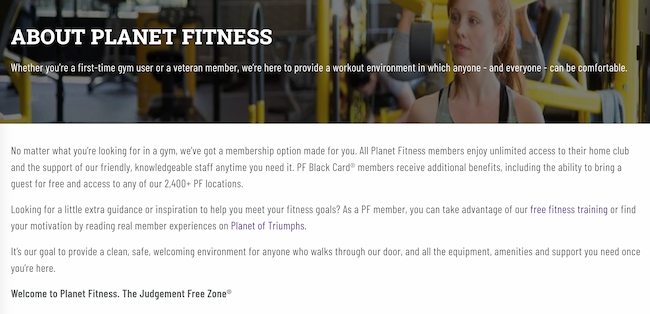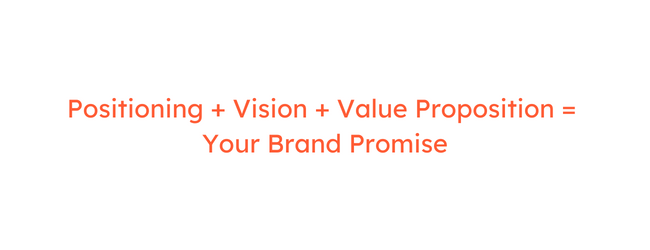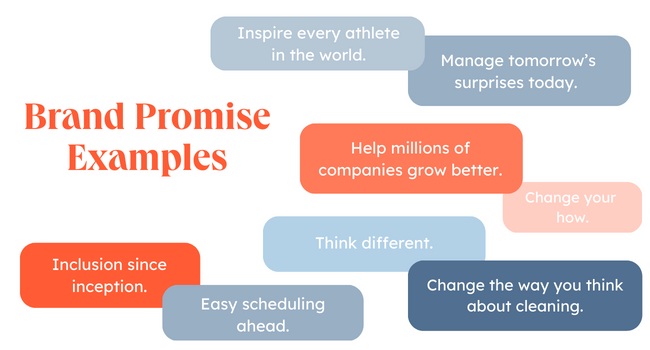A brand promise is more than a tagline. It’s a way to show customers what your brand can offer that no one else can.
Like other kinds of promises, brand promises can get complicated. They set high expectations, offer ambitious commitments, and impact relationships.
Let’s talk about what a brand promise is, how to create a brand promise, and see examples from popular B2B and B2C brands. We’ll also share a brand promise template to help you draft your own.
Keep reading or jump ahead to the section you’re looking for:
- What is a brand promise?
- Why Your Brand Promise Is Important
- How to Write a Brand Promise
- Brand Promise Template
- Brand Promise Examples
Your brand promise should be central to your company, something that remains constant as it grows and evolves.
Not every brand promise is explicit. It’s often more of an internal mantra that’s shared with employees, investors, and partners. But when you’ve built a strong brand identity and clear messaging, your brand promise can be assumed by your target audience.
Brand Promise vs. Tagline
There’s often some confusion between a brand promise and a tagline, so let’s break it down.

While it can be just as short as a tagline, a brand promise tells consumers, “Hey, this is what you’ll find every time you interact with our brand.”
So, why have one? Well, a brand promise:
- Helps internal and external stakeholders know what to expect from you.
- Gains consumer trust.
- Serves as the foundation from which you build out how your company operates from a consumer interaction perspective.
A Quick Brand Promise Definition
Brand promises are short statements. They make a commitment to your customer about what your brand will deliver.
It is a promise after all. So when you break it, it can affect your reputation and your revenue.
For instance, let’s say your brand promise is something like “Innovation at every turn,” and your company hasn’t come out with something new and fresh in the last five years. That can deter potential consumers.
Here are the most common types of brand promises:
- Emotional: A promise appealing to emotion.
- Action-based: A promise tied to a specific action.
- Social: A promise based on ethical or social responsibility.
Why Your Brand Promise Is Important
This one message can have a big impact on customer sentiment, brand reputation, and more.
Because a brand promise is like a pinky promise. For the uninitiated, a pinky promise is usually between two people. It holds more weight than a spit shake, legal contract, verbal agreement, and “I swear on my [insert family member]” statements combined. It’s part of our social contract – once it’s been agreed upon, it cannot be broken.
Your brand promise is the scaled, commercial version of a pinky promise, with your brand holding up one finger and your target audience holding up the other.
Except, in this case, breaking it won’t just ruin your reputation, it can impact your revenue. This promise can affect your market valuation, employees, and stakeholders.
Making good on your brand promise can help you grow your brand, build trust with your target audiences, and boost your sales.
But how can you pack all that power into a single message? Let’s talk about how to create your brand promise.
How to Write a Brand Promise
1. Focus on your audience.
Your brand promise outlines your commitment to your audience. So, to figure out what your promise should be, your first step is determining what your audience wants from you.
It goes beyond a specific product or service, it’s more specific to the experience you’re providing.
For instance, Planet Fitness’s brand promise is based on people’s reluctance to join the gym for fear of judgment and embarrassment. The brand, in response, promises to create an environment that encourages people at all fitness levels to go to the gym and feel comfortable working out.
Another goal of your brand promise is to set you apart from your competitors. What makes you unique, is it your customer service, your product, your mission, your values? Use that to offer a promise that’s distinctive.

In Planet Fitness’ case, the brand did something no one else had done: Address the problem with the gym environment, not its users.
As you learn about what your audience wants, keep asking questions. Do you know what their knowledge level is about your industry? Do you have a clear idea of what they need to know to make a purchase?
It’s important to remember that your brand promise isn’t simply a slogan or commitment. It’s the first step in building a community with shared values. The better you understand your audience, the more likely you are to engage them.
If you haven’t already, develop buyer personas and workshop messages that could resonate with each persona.
Featured Resource: Make My Persona
2. Think about your customer touchpoints.
With your brand promise, you’re guaranteeing something to your customers.
Whether your customer is in-store, on social media, or buying online, place yourself in their shoes and envision how you want those interactions to go. Is there a specific feeling involved? What do they have to gain?
For example, say a customer spends a lot of time on your website but hasn’t made a purchase. Do you have an idea about why they’re hesitating? If you were speaking to this customer in person, what would you say to help them move to the next step?
Once you put those feelings into words, you’ll be able to craft a brand promise that reflects the experience you want to promote.
You may also want to draft three or more secondary promises for each touchpoint at this stage. You may use these drafts to get to your main brand promise. This exercise can also help you narrow your focus to different touchpoints and how they can impact customer experience.
Your brand promise should be consistent across every touchpoint. So, the more time you spend looking at it from every angle, the more likely you are to create a powerful brand promise.
Featured Resource: Customer Journey Map Template
3. Keep it simple, unique, and inspiring.
Your brand promise should be clear and to the point, something you can say in one sentence. It won’t necessarily be as fun as a tagline, but it should definitely inspire trust and confidence.
Try to organize your ideas before you start writing. Having a concise idea of what you want to communicate can make writing easier.
Then, be thoughtful about which words you choose. Does your brand promise need complicated words or industry-specific terms? Is your brand promise about selling an offer or explaining your product? Answering these questions can help you find the right vocabulary for your promise.
Next, introduce some play into your writing. Think about your company culture, awakening the senses, and details that can paint a picture for your audience. This process will probably create more text than you’ll need, but it can help you create a promise with an authentic and empathetic voice.
Then you can edit your brand promise into a single succinct statement that is useful, positive, and hopeful.
If you can’t articulate your promise in this way, perhaps you haven’t fully fleshed out your brand’s purpose.
If that’s the case, start by asking yourself these questions:
- What should my customers expect from me?
- What does my company stand for?
- What makes us unique?
What makes a brand promise successful?
Unlike a promise between two friends, a brand promise is a public agreement with a vast audience. You don’t have to offer a brand promise, but if you choose to, it will set expectations for your community.
That’s because saying you’ll do something is easy, but it can be difficult to follow through. And an inability to follow through on your brand promise can have a long-term effect on brand perception.
To get the most out of your brand promise, test it against the benchmarks below.
Your brand promise should be credible.
Your brand promise should be something that your business or product is qualified to offer. Brand promises that offer too much or don’t align with industry expectations can make customers question their authenticity.
An effective brand promise can offer clues about your business like:
- Level of professional experience
- Knowledge of complex issues
- The character of your employees
This statement can also show your commitment to solving a specific problem for your customers.
Your brand promise should be memorable.
It’s not enough to just grab attention with your brand promise. Instead, you want people to remember your promise and connect it to your brand and products long-term.
Memorable brand promises evoke emotion, draw attention, and offer an audience something new. To create strong emotions, think about the emotions that come up when your customers solve a problem with your product or service. Then analyze the strength of these emotions. You can also look at how different situations might evoke different emotions.
This act of seeing from your customer’s perspective can help you create a “sticky” brand promise.
Your brand promise should have business impact.
In promises between friends, both make the promise because both get something out of it.
So, your brand promise should support what matters most to your business. It might convey product excellence, drive sales, or expand brand influence. And as people in your organization make decisions, they should do so with your brand promise in mind.
As you work on your brand promise, think about it from the perspective of every department and team member in your company. This can help your promise to inspire your employees and support the culture of your business too.
Your brand promise should be actionable.
A brand promise is an offer that a business needs to keep. This means that the promise must be something your company can act on.
As you review your brand promise, ask yourself:
- Is your brand promise also a call-to-action?
- What do your customers get in return if they commit to your brand?
- How can your audience engage or get involved with your brand promise?
- What other questions might someone ask after seeing your brand promise?
To be effective, your brand promise needs to be something your stakeholders can act on or see you taking action on, plus why that action is valuable. If your promise is vague or static, you may need to keep working.
Brand Promise Template
There isn’t an exact formula to create your brand promise. But we’ve mentioned that it’s a blend of a few things that make up your company. So here’s a formula you can use to create your promise:

Positioning + Vision + Value Proposition = Your Brand Promise
Write your answers down and start blending these concepts together into one succinct idea.
Crafting your brand promise should be a top priority when developing your identity. Without this core message, you will likely struggle to develop your brand identity and strong messaging to connect with your target audience.
As with everything, expect to have a few iterations. You won’t always have the answer right away.
It may take a few sessions to flesh it out and that’s OK. Because once you have it, it will become ingrained both internally and externally as your company grows.
Brand Promise Examples

Keep in mind that some of these examples of brand promises are assumed and some have been shared by the companies. Use them as inspiration when crafting your own.
- Nike — Inspire every athlete in the world.
- Apple — Think differently.
- Starbucks — To inspire and nurture the human spirit – one person, one cup, one neighborhood at a time.
- Coca-Cola — Refresh the world in mind, body, and spirit, and inspire moments of optimism.
- Anima Iris — Feel empowered and emboldened.
- Telfar — Redefine luxury as accessible and inclusive.
- Tru Colour — Inclusion since inception.
- Noirbnb — Create a safe space for POC to travel and discover new adventures.
- Pur Home Clean — Change the way you think about cleaning.
What’s common across all these promises is that they never refer to a particular offering or numerical goal. Instead, they are statements that encompass the brand’s broader purpose.
Examples of Brand Promises for B2B
Business-to-business brand promises can be difficult to craft. This is because these relationships are often more about efficiency and ROI than meeting emotional needs.
Check out these B2B brand promise examples to spark your imagination.
- HubSpot — Help millions of companies grow better.
- Datadog — See inside any stack, any app, at any scale, anywhere.
- MURAL — Change your how.
- Recurly — Keep a good thing growing.
- Calendly — Easy scheduling ahead.
- Reachdesk — Unlock the power of gifting at scale.
- LogicManager — Manage tomorrow’s surprises today.
- Muck Rack — Smarter PR with powerful, easy-to-use software.
- Gro Intelligence — See the big picture, act on the small details.
Build Your Brand Promise for Lasting Results
Some promises last for a lifetime. To make sure that you’re creating a brand promise for the long haul, give it some time.
Drafting a quick slogan can feel like the best choice when your team is running up against a deadline. But whether you draft your promise as part of larger branding efforts or as an add-on to your latest website redesign, it needs to be just right.
Take a look at the tips, templates, and examples above, and let your creativity run wild. Your brand may already have a strong identity, but how are you committing to your customers? Tell them today, with your brand promise.
Editor’s note: This post was originally published in June 2021 and has been updated for comprehensiveness.
![]()


